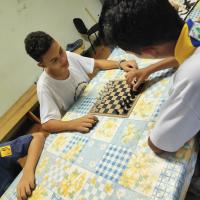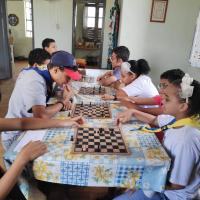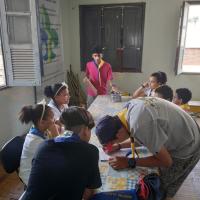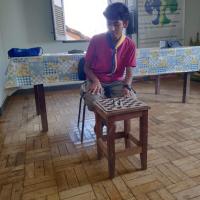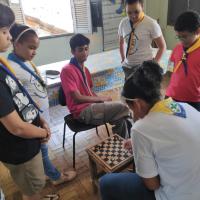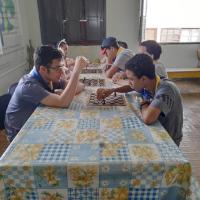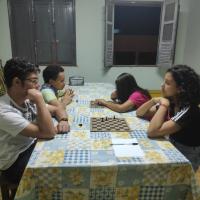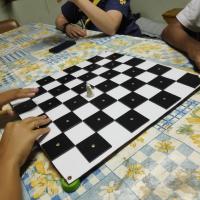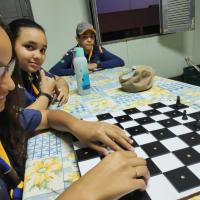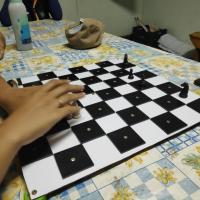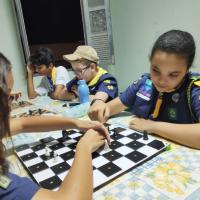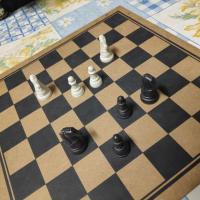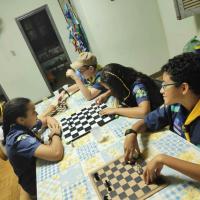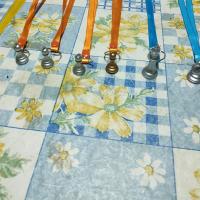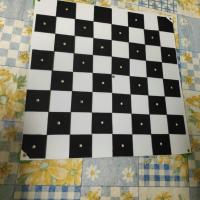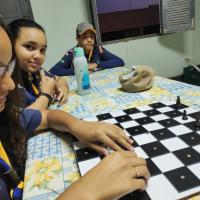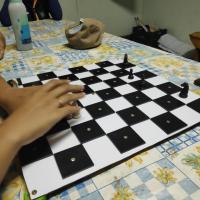
A boa ação ensinando Xadrez
The activities were held at the headquarters of the Scout Group Paracatu 14 ° Minas Gerais, Brazil. The aim of the project was to contribute to the students' teaching / learning process by providing participants with a voluntary form of opportunity to improve their cognitive functions, as well as providing an environment of interaction among community members using game techniques. chess and improve the application of motor activity and in the face of different situations, learn to make their decisions made. Gambling develops the responsibility of making decisions. Participants experience greater mastery of their skills in complex situations so that they can see more clearly and powerfully or follow the following choices. Chess practice is also a learning facilitator, contributing to the understanding of chemistry-related subjects. , physics, math and other areas. All activities were developed under the principle of student autonomy. To this end, various types of activities and different types of logic were performed for young people. The following activities were passed:
Activity 1: The board, where it was explained about house cores, rows, diagonals, columns, and the correct position of the board to start a game.
Activity 2: Starting position of the pieces, where all the pieces were placed correctly and some rules explained.
Activity 3: The pawn. In this activity, the main objective was to make the students could learn about a description of the piece, the movement of the piece and to finish it was passed a small exercise for those who were to be fixed on the students. The activity was based on who was able to arrive with a piece next to the board, being who started as white.
Activity 4: A tower. In this activity, the main objective was to make the students could learn about a description of the piece, the movement of the piece and to finish it was passed a small exercise for those who were to be fixed on the students. The activity was based on who had a tower that should capture all the members and who was with the members should promote only one of them.
Activity 5: The bishop. In this activity, the main objective was to make the students could learn about a description of the piece, the movement of the piece and to finish it was passed a small exercise for those who were to be fixed on the students. In the same logic as activity 6, those who play with bishops must capture all items and those who use items that only promote one of them before all these pieces are captured.
Activity 6: The horse. In this activity, the main objective was to make the students could learn about a description of the piece, the movement of the piece and to finish it was passed a small exercise for those who were to be fixed on the students. In this activity, both had the same pieces, and the goal of both was to promote a piece, but the captured horses or pawns.
Activity 7: The Lady. In this activity, the main objective was to make the students could learn about a description of the piece, the movement of the piece and to finish it was passed a small exercise for those who were to be fixed on the students. The objective of this game was to capture all the pieces and who was with black pieces precisely to promote a pawn.
Activity 8: The king. In this activity, the main objective was to make the students could learn about a description of the piece, the movement of the piece and to finish it was passed a small exercise for those who were to be fixed on the students. The main purpose of this game was simply to use the king's move and checkmate.
Activity 9: Roque. In this activity, the main goal was to make the students learn about the movement of the pieces and finish after a little exercise for what was done before being fixed on the students. The intent of this game was to show the castling movement, a movement in most games used by chess players.
Activity 10: Clock. In this main activity or objective, it was to enable students to learn about the description of the clock, use and exclude to finish after a small exercise for those who were set to be fixed on the students. No chess match case with watch use.
Activity 11: The en passant. In this activity, the main objective was to make the students learn about this movement, a movement of the pieces and finish after a last small exercise for those who were to be fixed on the students.
All of these activities were started for students who could learn about the pieces used in the game. As such, past activities were then related to strategies within the game, such as moves to make and moves to avoid.
Among the main activities performed during the project was a chessboard adapted to the project allowed for everyone.
As atividades foram realizadas na sede do Grupo Escoteiro Paracatu 14 ° Minas Gerais, Brasil . O objetivo do projeto foi contribuir com o processo de ensino / aprendizagem dos alunos, oferecendo aos participantes uma forma voluntária de uma oportunidade de aperfeiçoar suas funções cognitivas, além de ofertar um ambiente de interação entre os membros da comunidade usando-se como técnicas do jogo de xadrez e melhorar a aplicação de atividade motora e diante de diferentes situações, aprender a tomar suas decisões tomadas. O jogo desenvolve a responsabilidade de tomar decisões. Os participantes experimentam o maior domínio de suas habilidades em situações complexas, de modo a visualizar com maior clareza e poder ou seguir as seguintes escolhas.A prática do xadrez também é um facilitador da aprendizagem, contribuindo para o aprendizado da compreensão de conteúdos relacionados à química, física, matemática e outras áreas. Todas as atividades foram desenvolvidas sob o princípio da autonomia do aluno. Para isso, foram executados diversos tipos de atividades e diferentes tipos de lógica para jovens. Foram passadas as seguintes atividades:
Atividade 1: O tabuleiro, onde foi explicado sobre núcleos de casas, sobre filas, como diagonais, como colunas e a posição correta do tabuleiro para iniciar um jogo.
Atividade 2: Posição inicial das peças, onde todas as peças foram posicionadas de forma correta e explicadas algumas regras.
Atividade 3: O peão. Nessa atividade, o principal objetivo era fazer com que os alunos pudessem aprender sobre uma descrição da peça, a movimentação da peça e para finalizar foi passado um pequeno exercício para quem foi passado a ser fixado nos alunos. A atividade baseava-se em quem conseguiu chegar com um pedaço ao lado do tabuleiro, sendo quem começou como branco.
Atividade 4: Uma torre. Nessa atividade, o principal objetivo era fazer com que os alunos pudessem aprender sobre uma descrição da peça, a movimentação da peça e para finalizar foi passado um pequeno exercício para quem foi passado a ser fixado nos alunos. A atividade baseava-se em quem estava com uma torre que deveria capturar todos os membros e quem estava com os membros deveria promover apenas um deles.
Atividade 5: O bispo. Nessa atividade, o principal objetivo era fazer com que os alunos pudessem aprender sobre uma descrição da peça, a movimentação da peça e para finalizar foi passado um pequeno exercício para quem foi passado a ser fixado nos alunos. Na mesma lógica que a atividade 6, quem joga com os bispos deve capturar todos os itens e quem usa com os itens que apenas promove um deles antes de todas essas peças serem capturadas.
Atividade 6: O cavalo. Nessa atividade, o principal objetivo era fazer com que os alunos pudessem aprender sobre uma descrição da peça, a movimentação da peça e para finalizar foi passado um pequeno exercício para quem foi passado a ser fixado nos alunos. Nessa atividade, ambos possuíam as mesmas peças, sendo que o objetivo de ambos era promover uma peça, porém, os cavalos capturados ou peões.
Atividade 7: A dama. Nessa atividade, o principal objetivo era fazer com que os alunos pudessem aprender sobre uma descrição da peça, a movimentação da peça e para finalizar foi passado um pequeno exercício para quem foi passado a ser fixado nos alunos. O objetivo desse jogo era capturar todas as peças e quem estava com peças negras precisamente promover um peão.
Atividade 8: O rei. Nessa atividade, o principal objetivo era fazer com que os alunos pudessem aprender sobre uma descrição da peça, a movimentação da peça e para finalizar foi passado um pequeno exercício para quem foi passado a ser fixado nos alunos. O objetivo principal desse jogo era simplesmente usar o movimento do rei e usar o xeque mate.
Atividade 9: Roque. Nessa atividade, o objetivo principal era fazer com que os alunos pudessem aprender sobre o movimento das peças e finalizar após um pequeno exercício para o que foi feito antes de ser fixado nos alunos. A intenção desse jogo era mostrar o movimento roque, um movimento na maior parte das partidas e usado pelos jogadores de xadrez.
Atividade 10: Relógio. Nessa atividade ou objetivo principal, era fazer com que os alunos pudessem aprender sobre a descrição do relógio, usar e excluir para finalizar após um exercício pequeno para quem foi passado a ser fixado nos alunos. Nenhum caso de partida de xadrez com uso do relógio.
Atividade 11: O en passant. Nessa atividade, o objetivo principal era fazer com que os alunos pudessem aprender sobre esse movimento, uma movimentação das peças e finalizar após um último exercício pequeno para quem foi passado a ser fixado nos alunos.
Todas essas atividades foram iniciadas para os alunos que puderam aprender sobre as peças usadas no jogo. Com isso, como atividades passadas logo em seguida foram relacionadas às estratégias dentro do jogo, como jogadas a fazer e jogadas a evitar.
Dentre as principais atividades executadas durante o projeto, foi realizado um tabuleiro de xadrez adaptado para o projeto permitido a todos.
